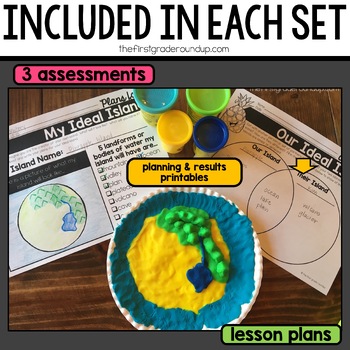Island Landform Map Activities & STEM Challenge for Second Grade Science
- PDF
What educators are saying
Also included in
- The Next Gen Science and standards give LOTS of opportunity for STEM challenges and STEAM activities. These 10 STEM challenges align with the engineering standards in kindergarten, first, and second grade NGSS. Your kids will love working together to build solutions to these real-world problems!STPrice $19.50Original Price $30.00Save $10.50
Learning Objective
TSW plan, design and build an ideal island with various landforms in this STEM challenge.
Description
This Island Landform Map Project and STEM challenge addresses the Earth Science standards in Next Gen Science Standards for second grade science. Your kids will love working to build their own island in this engaging landforms and bodies of water activity.
THE FOLLOWING EARTH SCIENCE NEXT GEN STANDARDS ARE ADDRESSED
Landforms 2nd Grade: 2-ESS2-1, 2-ESS2-2, 2-ESS2-3
INCLUDED IN THIS ISLAND LANDFORM MAP PROJECT & STEM CHALLENGE
- Detailed lesson plans and links to outside resources or videos
- Digital pdf file of STEM challenge slides by step (problem, plan, build, share, publish)
- Planning page handout
- Publishing and reflecting page handout
- Group and individual rubric
- Self-assessment checklist
- Word search for early finishers and answer key
- Invent me anchor chart
- Star-Star-Wish anchor chart and templates in color and B/W
- How to use this resource notes
OTHER SUPPLIES SUGGESTED FOR THIS LANDFORM PROJECT
- paper plates
- construction paper
- playdoh
- toothpicks
- labels
TEACHERS LIKE YOU SAID…
⭐️⭐️⭐️⭐️⭐️ “My STREAM kiddos had so much fun with this project at the end of the year. It ties with a variety of literacy standards too!” ~Sarah
⭐️⭐️⭐️⭐️⭐️ “My second graders loved this project! I used this as an end-of-unit project when students were learning about landforms. They loved that it was hands on and that they got to be creative.” ~Ellen
⭐️⭐️⭐️⭐️⭐️ “We had so much fun with this activity! My students were engaged and learned alot about landforms. I wish every unit I teach could be this engaging!” ~Amanda
⭐️⭐️⭐️⭐️⭐️ “I adapted this to use with 2nd-5th grade students at a summer camp at my school. I did it with two different groups of students. The students were so engaged and wanted to keep working on their projects and trying new ideas. I will definitely use this again in the future!” ~Carolyn
⭐️ BUNDLE & SAVE FOR A DISCOUNT ⭐️
Purchase the Next Gen Science STEM Challenges to get 10 STEM challenges to meet the K-2 engineering science standards.
You may also like…
→ Landforms 2nd Grade Science Unit
→ Landforms Non Fiction Decodable Texts
Having difficulty with a file?
Visit the FAQs section, submit a help ticket, or ask a question on the Q&A tab before leaving feedback.
___________________________________
Copyright © The First Grade Roundup by Whitney Shaddock.
Permission to copy for single classroom use only.
Please purchase additional licenses if you intend to share this product.
LET'S CONNECT






